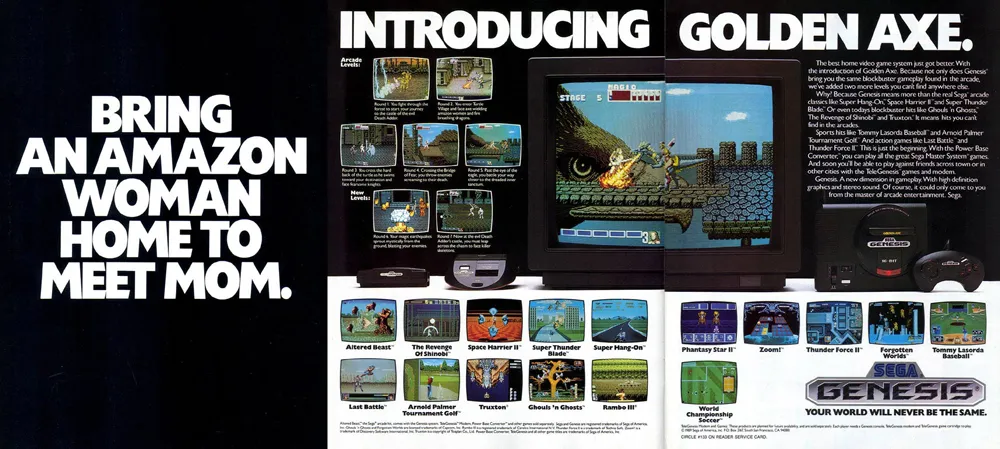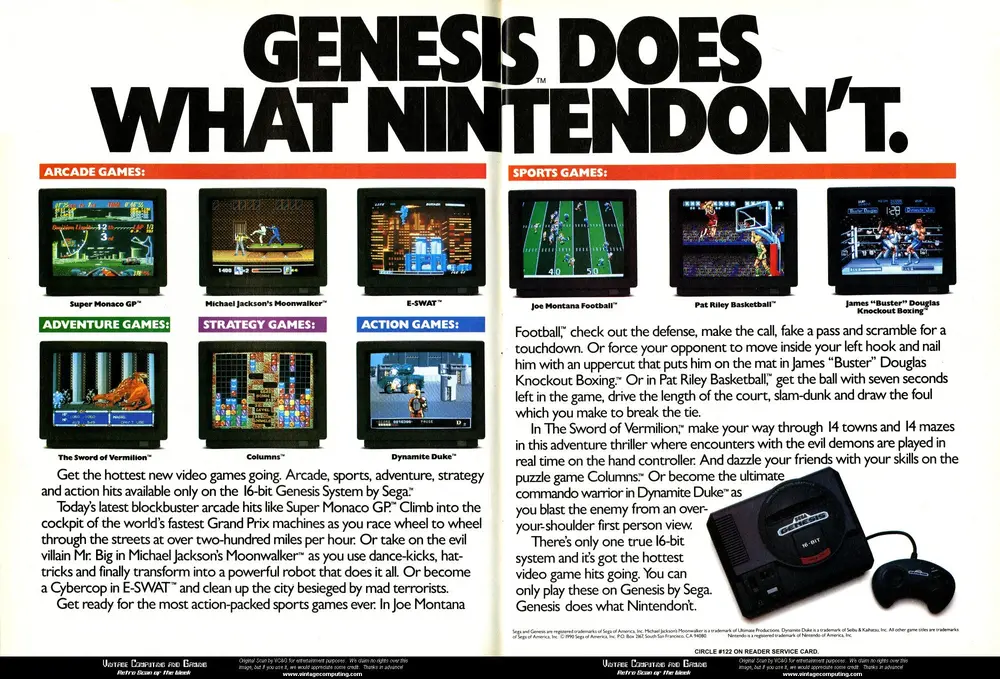In the early 1990s, the video game industry witnessed a fierce battle between console giants, with Sega’s Genesis (Mega Drive outside North America) emerging as a formidable competitor against Nintendo’s dominance. This success was not just a result of innovative technology or an extensive library of games; Sega’s marketing strategies played a pivotal role in shaping the Genesis’s destiny. This article delves into the creative and aggressive marketing tactics Sega employed, which not only carved a niche for the Genesis but also redefined video game advertising.
Key Takeaways
| Aspect | Impact |
|---|---|
| Creative Campaigns | Sega’s memorable “Genesis does what Nintendon’t” campaign highlighted the Genesis’s unique offerings, directly challenging Nintendo’s market dominance and appealing to a teenage demographic seeking an edgier gaming experience. |
| Celebrity Endorsements | Collaborations with popular figures and athletes, such as Michael Jackson and Joe Montana, boosted the Genesis’s cool factor and broadened its appeal beyond traditional gaming audiences. |
| Technological Superiority | Marketing that emphasized the Genesis’s superior graphics and sound quality attracted gamers looking for a more immersive experience, positioning the console as a cutting-edge option. |
| Strategic Partnerships | Partnerships with third-party game developers expanded the Genesis’s game library, offering exclusive titles that became synonymous with Sega’s brand and leveraged in marketing to showcase the console’s diverse offerings. |
Sega’s entry into the console market faced significant challenges, notably Nintendo’s near-monopoly. However, through a combination of savvy marketing strategies and understanding of the target audience, Sega managed to not only break into the market but also establish the Genesis as a cultural icon of its time.

Creative Campaigns: “Genesis Does What Nintendon’t”
At the heart of Sega’s marketing triumph was the ingeniously simple yet profoundly impactful slogan “Genesis does what Nintendon’t.” This catchphrase was more than just a clever jibe at its main competitor; it encapsulated Sega’s daring approach to positioning the Genesis in the video game market. The campaign was groundbreaking, not only for its direct comparison to Nintendo but for how it communicated the value proposition of the Genesis to consumers. It underscored the console’s ability to offer something unique and superior, specifically targeting an audience that craved more sophisticated and adult-oriented gaming experiences than what was predominantly available.
The campaign’s brilliance lay in its directness and simplicity, cutting through the advertising noise with a message that resonated deeply with gamers. It effectively highlighted the Genesis’s strengths, such as its advanced graphics, faster processing power, and an edgier game library, which appealed to teenagers and young adults looking for a more mature gaming experience. This strategy tapped into a growing market segment that felt overlooked by Nintendo’s more family-friendly focus, setting the stage for Sega to capture and dominate this demographic.
Moreover, “Genesis does what Nintendon’t” wasn’t just a tagline; it became a rallying cry for Sega fans, embodying the brand’s identity as a bold, innovative, and slightly rebellious contender in the gaming industry. This campaign did more than sell a product; it created a community of loyal followers who identified with Sega’s brand ethos, further amplifying the Genesis’s success through word-of-mouth and peer influence. Sega’s marketing acumen, epitomized by this campaign, was instrumental in not only breaking Nintendo’s stronghold on the market but also in defining the cultural and competitive landscape of the video game industry during the early ’90s.
Celebrity Endorsements and Partnerships
Sega’s strategic use of celebrity endorsements and partnerships was a masterstroke in marketing the Genesis, setting it apart in a crowded market. By aligning the console with high-profile personalities from the worlds of sports, music, and entertainment, Sega not only amplified its brand visibility but also infused the Genesis with a sense of prestige and aspiration. This move was particularly effective in the context of the early 1990s, a time when celebrity culture was becoming increasingly influential in consumer behavior.
The involvement of celebrities like Michael Jackson in the creation of Michael Jackson’s Moonwalker and sports icons such as Joe Montana for Joe Montana Football went beyond mere endorsements. These collaborations resulted in exclusive, branded content that not only showcased the technical capabilities of the Genesis but also offered fans a unique way to connect with their idols. This blend of gaming and celebrity culture proved to be a potent marketing mix, attracting a broader audience to the Genesis platform.
Furthermore, these partnerships highlighted Sega’s commitment to innovation and quality. By working directly with celebrities to develop games, Sega ensured that these titles were not just marketing gimmicks but valuable additions to the Genesis library. This strategy reinforced the console’s image as a cutting-edge platform that offered unique and immersive gaming experiences, further cementing its place in the hearts of gamers and pop culture enthusiasts alike.
The success of Sega’s celebrity endorsements and partnerships demonstrated the power of leveraging star power to create a brand identity that resonated with consumers. It was a testament to Sega’s understanding of the cultural zeitgeist and its ability to adapt its marketing strategies to capture the imagination of a diverse and expanding audience. This approach not only contributed significantly to the Genesis’s success but also set a precedent for future collaborations between the gaming industry and celebrity culture.
Emphasis on Technological Superiority
Sega’s emphasis on technological superiority with the Genesis console was a calculated move that played a pivotal role in distinguishing it from competitors, primarily Nintendo. In the late 1980s and early 1990s, the video game industry was at a crucial juncture, with advancements in technology rapidly changing what was possible within the confines of home entertainment systems. Sega capitalized on this moment of transition by positioning the Genesis as the epitome of next-generation gaming, thanks to its then-revolutionary 16-bit processor. This focus was not merely a matter of boasting about hardware specs; it was a strategic effort to align the Genesis with the future of gaming and to appeal to an audience that was increasingly sophisticated and discerning in its entertainment choices.
The Genesis’s 16-bit architecture allowed for a quantum leap in the quality of gaming experiences. Games could now feature more detailed graphics, richer soundscapes, and more complex gameplay than their 8-bit predecessors. Sega did not shy away from highlighting these capabilities in its marketing efforts, often directly comparing the Genesis’s performance to that of the 8-bit systems that dominated the market at the time. This direct comparison was not just about showcasing superior technology; it was about illustrating the tangible benefits that this technology brought to gamers. Sega’s message was clear: the Genesis was not just a new console but a new standard for what gaming could be.
Beyond the hardware itself, Sega’s emphasis on technological superiority extended to the development and promotion of games that could fully leverage the Genesis’s capabilities. Titles like “Sonic the Hedgehog” became showcases for the system’s graphical prowess and fast processing speeds, offering gameplay experiences that were both visually stunning and technically smooth. These games were not just fun to play; they were demonstrations of the Genesis’s superiority over its competitors.
Moreover, Sega’s approach to technology was not static. The company continually innovated, introducing add-ons like the Sega CD and the 32X to further enhance the Genesis’s capabilities. While these peripherals had varying degrees of success, their introduction reinforced Sega’s image as a forward-thinking company that was committed to pushing the boundaries of video game technology.
This emphasis on technological superiority did more than just sell consoles; it shaped the identity of the Genesis and its place in video game history. Sega managed to create a narrative around the Genesis that went beyond the bits and bytes of its hardware. It was a narrative about innovation, about experiencing the future of gaming today, and about belonging to a community that was at the forefront of this technological revolution. This narrative resonated with gamers, contributing significantly to the Genesis’s success and leaving a lasting legacy in the industry.
In conclusion, Sega’s focus on technological superiority with the Genesis was a multifaceted strategy that combined advanced hardware, groundbreaking games, and a compelling narrative about the future of gaming. This approach not only set the Genesis apart from its competitors but also helped to define an era of video game history, demonstrating the power of technology to transform entertainment and culture.
Strategic Content and Partnerships
Sega’s strategic content and partnerships for the Genesis console were critical components of its success, showcasing an understanding of the gaming market that went beyond hardware. Sega knew that to sustain and grow the Genesis’s market presence, it needed a strong lineup of games that appealed to a broad audience. To achieve this, Sega cultivated partnerships with third-party developers, a move that diversified the Genesis’s game library and solidified its competitive edge.
These partnerships were instrumental in bringing a wide array of titles to the Genesis, including genre-defining classics and innovative games that leveraged the console’s technological capabilities. By opening its platform to third-party developers, Sega was able to offer an expansive and varied catalog of games, from action and adventure to sports and RPGs. This variety not only attracted gamers with different interests but also kept the console’s offerings fresh and compelling over its lifespan.
Sega’s strategic content collaborations extended to securing exclusive titles that became synonymous with the Genesis brand. Games like “Sonic the Hedgehog” were not just commercial successes; they became cultural icons that defined the gaming experience for a generation. These exclusive titles were critical in differentiating the Genesis in a crowded market, providing gamers with unique experiences they couldn’t find elsewhere.
Moreover, Sega’s partnerships often involved working closely with developers to ensure that games maximized the technical capabilities of the Genesis, resulting in titles that were not only fun to play but also showcased the console’s superiority in graphics and sound. This collaborative approach to game development underscored Sega’s commitment to quality and innovation, further enhancing the Genesis’s reputation among gamers.
The strategic content and partnerships Sega pursued for the Genesis exemplify the company’s holistic approach to competing in the video game market. By fostering a diverse and dynamic game library, Sega was able to appeal to a wide audience, sustain interest in the Genesis over time, and ultimately secure a lasting legacy in the history of video gaming. This strategy highlighted the importance of software in driving hardware success, a lesson that remains relevant in the gaming industry today.
